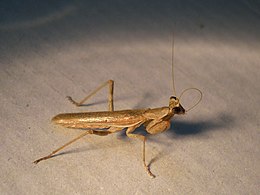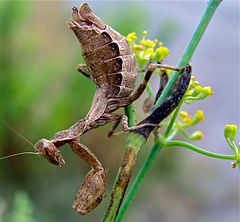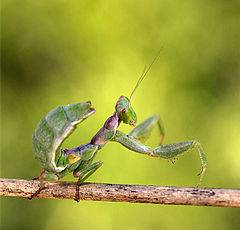
The Chinese mantis is a species of mantis native to Asia and the nearby islands. In 1896, this species was accidentally introduced by a nursery tender at Mt. Airy near Philadelphia, United States. Tenodera sinensis often is erroneously referred to as Tenodera aridifolia sinensis because it was at first described as a subspecies of Tenodera aridifolia, but Tenodera sinensis is now established as a full species.

The European mantis is a large hemimetabolic insect in the family of the Mantidae ('mantids'), which is the largest family of the order Mantodea (mantises). Their common name praying mantis is derived from the distinctive posture of the first pair of legs that can be observed in animals in repose. It resembles a praying attitude. Both males and females have elongated bodies with two pairs of wings. The most striking features that all Mantodea share are a very mobile, triangular head with large compound eyes and their first pair of legs, which is highly modified for the efficient capture and restraint of fast-moving or flying prey.

Mantidae is one of the largest families in the order of praying mantises, based on the type species Mantis religiosa; however, most genera are tropical or subtropical. Historically, this was the only family in the order, and many references still use the term "mantid" to refer to any mantis. Technically, however, "mantid" refers only to members of the family Mantidae, and not the 14 remaining families of mantises. Some of the most recent classifications have promoted a number of the mantid subfamilies to the rank of family, e.g. Iridopterygidae, Sibyllidae, Tarachodidae, Thespidae, and Toxoderidae, while other classifications have reduced the number of subfamilies without elevating to higher rank.

Tenodera is a genus of mantis in the family Mantidae which contains several species of praying mantises. The species in this genus can be found primarily in Africa, Asia and Australia, but also North America.

Hymenopus coronatus is a mantis from the tropical forests of Southeast Asia. It is known by various common names including walking flower mantis and (pink) orchid mantis. It is one of several species known as flower mantises from their resemblance and behaviour. They are known to grab their prey with blinding speed.

Iris oratoria, known by the common name Mediterranean mantis, due to humans first studying it in lands around the Mediterranean Sea, is a species of praying mantis. Its range is expanding in the Middle East, Western Asia and the United States.

Liturgusidae is a family of praying mantises in the new (2019) Neotropical superfamily Acanthopoidea. A substantial number of genera, previously placed here, have recently been moved to the new or revived other families:
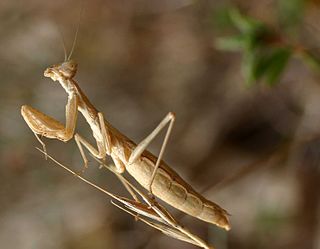
Ameles decolor is a species of small praying mantis native to the west Mediterranean and North Africa. A. decolor was first described by entomologist Domenico Cyrillo in 1787, and its current classification was established in 1976 by Karl Harz and Alfred Peter Kaltenbach. A. decolor presents as a small, light brown mantis with females tending to appear larger than their male counterparts. The mating patterns of A. decolor are considered some of the most complex amongst praying mantises, with males presenting two different styles of courtship. Their habitat favours shrublands, grasslands, and wooded areas.

Metallyticus splendidus is a rare species of praying mantis found in Southeast Asia. It has an iridescent appearance.

Empusa pennata, or the conehead mantis, is a species of praying mantis in genus Empusa native to the Mediterranean Region. It can be found in Portugal, Spain, southern France, Italy and on the mediterranean coasts of Morocco, Algeria, Tunisia, Libya and Egypt. Because of its cryptic nature, or also possibly because of its fragmented, low density populations, it is rare to encounter in the wild.

Rhombodera is a genus of praying mantises native to Asia and possessing common names such as shield mantis, hood mantis, and leaf mantis because of their extended, leaf-like thoraxes.

Mantises are an order (Mantodea) of insects that contains over 2,400 species in about 460 genera in 33 families. The largest family is the Mantidae ("mantids"). Mantises are distributed worldwide in temperate and tropical habitats. They have triangular heads with bulging eyes supported on flexible necks. Their elongated bodies may or may not have wings, but all Mantodea have forelegs that are greatly enlarged and adapted for catching and gripping prey; their upright posture, while remaining stationary with forearms folded, has led to the common name praying mantis.
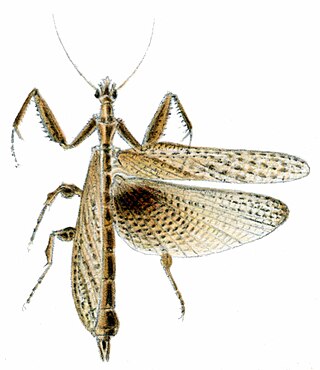
Stenophylla is a genus of praying mantis in the subfamily Stenophyllinae, which is now placed in the family Acanthopidae. It the sole genus of the tribe Stenophyllini.

Acontistini is a tribe of neotropical mantises in the superfamily Acanthopoidea, and family Acanthopidae. There are 7 genera and more than 30 described species in Acontistini. In 2016, several genera were moved from Acanthopidae to a newly created family Acontistidae, but this has not been accepted in most recent classifications.

Coptopterygidae is a family of mantises in the order Mantodea. There are at least 2 genera and more than 20 described species in Coptopterygidae.

Photinaidae is a family of mantises in the order Neotropical Mantodea, in the superfamily Acanthopoidea. There are about 11 genera and more than 40 described species in Photinaidae.
Thespinae is a subfamily of mantises in the family Thespidae. There are 16 genera and at least 40 described species: found in most continents.
Rhombomantis is a genus of mantids in the family Mantidae. There are at least four described species in Rhombomantis.

Pseudovates is a genus of praying mantis in the family Mantidae. There are more than 20 described species in the genus Pseudovates, and are found in North, Central, and South America.
